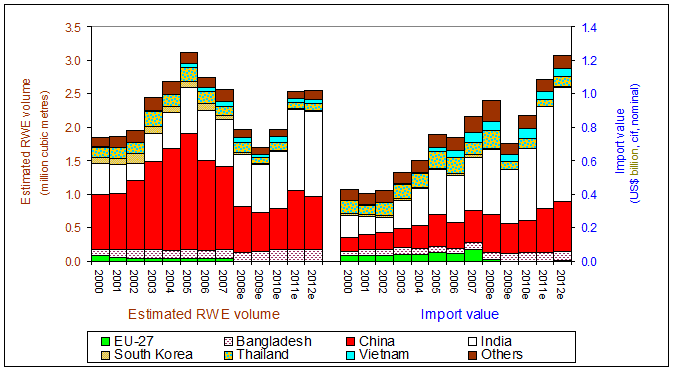|
|
||
|
Burma The proportion of the export value of Burma's exports fell from roughly 20% to 5% between 2000 and 2010, due primarily to increased exports of natural gas. Logs and, to a lesser extent, sawn wood account for almost all of the quantity of wood-based product which Burma exports. Chart 1 - Trade in timber from Burma{Footnote
1} Chart 1 shows that India imported almost 50% of the quantity of logs which importing countries reported as imports from Burma during 2010. China imported a further 30% of those logs and 80% of the sawn wood. India is said to be the (initial and probably final) destination for as much as 80% of Burma's exports of teak logs. Grossly unsustainable rates of logging during the previous (overtly military) government have caused the quality of timber being exported to decline and have prompted the current government to propose a log export ban starting in 2014. [p7] The great majority of China's imports of logs from Burma are supplied overland through Yunnan. China prohibited the overland import of timber from Burma during 2006, after exposÚs of their illegality and links to conflict. Imports through Yunnan resumed a year or two later. It is unclear whether the prohibition has been formally withdrawn or whether suppliers now comply with the terms of the Interim Measures prohibiting trade.[p13] The volume of logs imported through Yunnan has increased rapidly since mid-2010 - despite a further exposÚ during late 2009 - see Chart 2 below. The quantities of timber which Burma reports as exports overland to China are very much smaller than what China reports - illegality (and conflict) presumably explains the difference.[*] Enterprises which have (ethnic) links to Fujian are prominent in the distribution within China of timber imported from Burma, notably in Kunming.[penultimate ¶, p8][third ¶, p22] Access to what forest of commercial interest remains is likely to improve due to construction of major infrastructure links between China and the Indian Ocean and Bangladesh. Timber exports would help pay for this. The recent privatisation of assets controlled by the government is more likely to increase illegality in the supply of timber in Burma, particularly in so far as corruption is associated with that privatisation. There seems to have been no substantial research into the provenance of timber transported by sea from Burma. Almost all the timber which India imports from Burma is supplied by sea. Much of the timber which Burma exports to Thailand is likely to be supplied overland.{Footnote 2 } There has been extensive Thai involvement in Burma's timber industry - from logging and milling to the laundering of illegal Thai timber. From time to time, some overland borders have been closed to the transport of timber from Burma to Thailand. Prohibitions in the USA and [16:50-17:32]the EU against the import of timber from Burma, which were lifted during 2012, had no discernible impact on the quantity of timber being exported elsewhere. This implies that the quantities being subsequently exported from those other countries to the USA and EU - evading those prohibitions - were small relative to the total being exported from Burma. Conclusion: Almost all exports of timber from Burma are likely to be illegal, especially those imported overland by China. Chart 2 - China's imports of logs and sawn wood
from Burma - by Customs District{Footnote
3} Footnote 1: based on various official sources - see footnote 1. (Burma published its trade statistics for 2010 in UN Comtrade). Footnote 2: This current Thai activity differs from that which took place during the 1990s and which Global Witness has extensively documented. Footnote 3: Based on monthly statistics published by General Administration of Customs of the People's Republic of China. |
||
|
|
||


